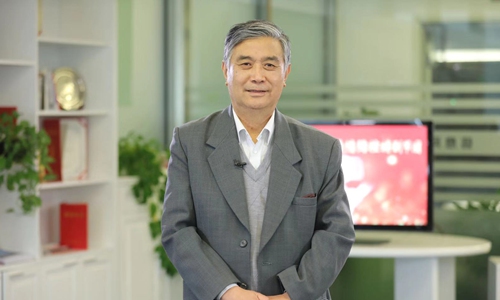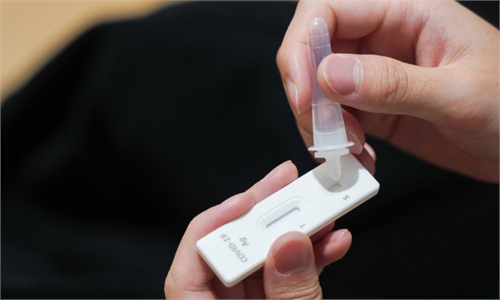Exclusive: Pre-pandemic normalcy will only return after management of COVID downgraded to Class C: top epidemiologist

Zeng Guang Photo: Courtesy of Zeng
Downgrading COVID-19 management from Class A to Class B mainly depends on if the scientific world is confident that the pathogenicity and mortality rates of coronavirus are decreasing, a former chief epidemiologist from the Chinese Center for Disease Control and Prevention (CDC) told the Global Times, saying the adjustment will be made an appropriate point in time.In an exclusive interview with the Global Times, Zeng Guang said that a move to such adjustments has gained momentum from within the scientific world. He pointed out that as the new variants of coronavirus are transmitting faster than ever, but cause lower pathogenicity rate with virus attacking more on the upper respiratory tracts than lungs; also, most of those infected are of mild or no symptoms.
The expert also said that even downgrading to Class B does not guarantee that people can return to pre-pandemic normalcy. Only after the country has absorbed the shocks from the virus, and the curve is flattened and COVID-19 be treated as flu, when no case numbers are reported each day and the focus is on treatment of severe cases, can management of COVID-19 be further downgraded to Class C, and then people can have their normal lives back, Zeng said.
China recently adjusted and optimized its COVID response by releasing 10 new measures, including allowing asymptomatic carriers and mild COVID-19 patients and those who meet certain requirements to quarantine at home. Accompanying the new adjustment are discussions as to whether management of COVID-19 should be downgraded to Class B among academicians.
Zeng said once scientists established consensus that variation of coronavirus continues to be less dangerous, China will downgrade management of COVID-19 at the right time.
COVID-19 was classified as a Class B infectious disease - a class that also includes HIV, viral hepatitis and H7N9 bird flu - on January 20, 2020 - a day after Beijing identified it could spread from between humans. However, the announcement noted that it should be managed like a category A disease, putting it on a par with bubonic plague and cholera.
Management of Class A diseases requires local governments to impose strong measures such as lockdowns, isolation and quarantine if needed; close contacts of those patients should also undergo medical observation and other measures to prevent virus from spreading, according to China's Law on the Prevention and Treatment of Infectious Diseases.
Downgrading management of COVID-19 to Class B means managing COVID-19 will return to the medical system's jurisdiction. Medical workers still need to diagnose, report and manage every case, and isolate patients as well as their close contacts; and disinfect every place where the virus breaks out. However, measures such as large-scale lockdowns imposed by local governments and movement restrictions will no longer be used, Zeng said.
China has categorized SARS, H1N1 flu and COVID-19 into Class B category disease but used a Class A management approach. Zeng said the previous experiences showed that adjustment of the management level also changes along with evolvement of pathogen and requirement of virus control, first to Class B and then to Class C.
After winning the fight against SARS in 2003, although the disease was treated by using Class A management, strict measures were no longer commonly deployed. Also, as H1N1 flue became less pathogenic since summer of 2009, the Chinese government downgraded management of the disease first to Class B and then to Class C, Zeng said.
Recently, several top Chinese expertsargued that the Omicron variants have displayed lessened virulence, pathogenicity and that conditions for downgrading management of COVID-19 are becoming more appropriate.
Tong Zhaohui, a respiratory and critical illness expert and director of the Beijing Institute of Respiratory Medicine, told the media on Tuesday that based on the data collected across the country, the number of asymptomatic carriers and patients experiencing mild syndromes now accounts for more than 90 percent total cases, and with the proportion of severe and critical cases only representing a small fraction.
Zhang Boli, an academician from the Chinese Academy of Engineering, told the Science and Technology Daily reported on Wednesday that conditions for treating COVID-19 scaled back to Class B control measures for infectious diseases are becoming mature in China.
Such adjustments can free up a large quantity of medical resources from makeshift hospitals which can be redeployed to normal medical treatment in addition to protecting vulnerable groups, and will serve to provide a legal basis for further optimization of prevention and control measures in the future, said Zhang.
China's recent measures of optimizing COVID-19 response are trending toward becoming more precise and scientific, and the public seems to see flicker of hope of returning to pre-pandemic life.
Liang Wannian, head of the COVID-19 response expert panel under the National Health Commission (NHC), said that forming deeper understanding of the virus, stockpiling effective vaccines and medicines, and improving capacity of dealing with emergencies are pre-conditions for returning to normalcy. "Currently, we need to pay attention to the variants of the virus, situation of severe and death cases, and strive to prevent crushing of medical resources. China has done ample efforts and taking measures to strengthen our preparation," Liang said.
Zeng believes that although the COVID-19 restrictive measures are being relaxed, and the society is enjoying more freedoms, it is not yet the time to return back to normal, as caseloads are soaring. COVID-19 will only be downgraded to Class C management after we weathered rounds of its shocks and inflation curve flattened; when the virus is being treated like flu where no daily caseload reports are needed, and the focus is shifted to severe cases and vaccination. Only when downgraded to category C management, people can really return to pre-pandemic normalcy, Zeng stated.
It is a key but difficult step to degrade management of COVID-19 from category A to B; as such change signals our response to coronavirus has changed substantially; once downgraded to Class B, it is only nature for the disease to be managed into category C, Zeng said.



